Noel Naughton
Neural reservoir control of a soft bio-hybrid arm
Mar 12, 2025Abstract:A long-standing engineering problem, the control of soft robots is difficult because of their highly non-linear, heterogeneous, anisotropic, and distributed nature. Here, bridging engineering and biology, a neural reservoir is employed for the dynamic control of a bio-hybrid model arm made of multiple muscle-tendon groups enveloping an elastic spine. We show how the use of reservoirs facilitates simultaneous control and self-modeling across a set of challenging tasks, outperforming classic neural network approaches. Further, by implementing a spiking reservoir on neuromorphic hardware, energy efficiency is achieved, with nearly two-orders of magnitude improvement relative to standard CPUs, with implications for the on-board control of untethered, small-scale soft robots.
Accelerated, physics-inspired inference of skeletal muscle microstructure from diffusion-weighted MRI
Jun 19, 2023Abstract:Muscle health is a critical component of overall health and quality of life. However, current measures of skeletal muscle health take limited account of microstructural variations within muscle, which play a crucial role in mediating muscle function. To address this, we present a physics-inspired, machine learning-based framework for the non-invasive and in vivo estimation of microstructural organization in skeletal muscle from diffusion-weighted MRI (dMRI). To reduce the computational expense associated with direct numerical simulations of dMRI physics, a polynomial meta-model is developed that accurately represents the input/output relationships of a high-fidelity numerical model. This meta-model is used to develop a Gaussian process (GP) model to provide voxel-wise estimates and confidence intervals of microstructure organization in skeletal muscle. Given noise-free data, the GP model accurately estimates microstructural parameters. In the presence of noise, the diameter, intracellular diffusion coefficient, and membrane permeability are accurately estimated with narrow confidence intervals, while volume fraction and extracellular diffusion coefficient are poorly estimated and exhibit wide confidence intervals. A reduced-acquisition GP model, consisting of one-third the diffusion-encoding measurements, is shown to predict parameters with similar accuracy to the original model. The fiber diameter and volume fraction estimated by the reduced GP model is validated via histology, with both parameters within their associated confidence intervals, demonstrating the capability of the proposed framework as a promising non-invasive tool for assessing skeletal muscle health and function.
Topology, dynamics, and control of an octopus-analog muscular hydrostat
Apr 17, 2023



Abstract:Muscular hydrostats, such as octopus arms or elephant trunks, lack bones entirely, endowing them with exceptional dexterity and reconfigurability. Key to their unmatched ability to control nearly infinite degrees of freedom is the architecture into which muscle fibers are weaved. Their arrangement is, effectively, the instantiation of a sophisticated mechanical program that mediates, and likely facilitates, the control and realization of complex, dynamic morphological reconfigurations. Here, by combining medical imaging, biomechanical data, live behavioral experiments and numerical simulations, we synthesize a model octopus arm entailing ~200 continuous muscles groups, and begin to unravel its complexity. We show how 3D arm motions can be understood in terms of storage, transport, and conversion of topological quantities, effected by simple muscle activation templates. These, in turn, can be composed into higher-level control strategies that, compounded by the arm's compliance, are demonstrated in a range of object manipulation tasks rendered additionally challenging by the need to appropriately align suckers, to sense and grasp. Overall, our work exposes broad design and algorithmic principles pertinent to muscular hydrostats, robotics, and dynamics, while significantly advancing our ability to model muscular structures from medical imaging, with potential implications for human health and care.
Hierarchical control and learning of a foraging CyberOctopus
Feb 11, 2023Abstract:Inspired by the unique neurophysiology of the octopus, we propose a hierarchical framework that simplifies the coordination of multiple soft arms by decomposing control into high-level decision making, low-level motor activation, and local reflexive behaviors via sensory feedback. When evaluated in the illustrative problem of a model octopus foraging for food, this hierarchical decomposition results in significant improvements relative to end-to-end methods. Performance is achieved through a mixed-modes approach, whereby qualitatively different tasks are addressed via complementary control schemes. Here, model-free reinforcement learning is employed for high-level decision-making, while model-based energy shaping takes care of arm-level motor execution. To render the pairing computationally tenable, a novel neural-network energy shaping (NN-ES) controller is developed, achieving accurate motions with time-to-solutions 200 times faster than previous attempts. Our hierarchical framework is then successfully deployed in increasingly challenging foraging scenarios, including an arena littered with obstacles in 3D space, demonstrating the viability of our approach.
Energy Shaping Control of a Muscular Octopus Arm Moving in Three Dimensions
Sep 09, 2022

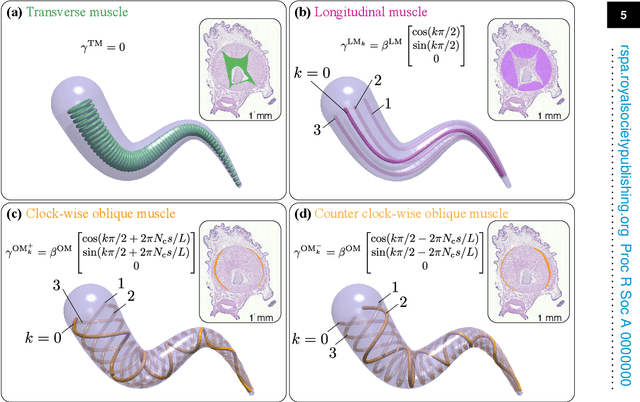

Abstract:Flexible octopus arms exhibit an exceptional ability to coordinate large numbers of degrees of freedom and perform complex manipulation tasks. As a consequence, these systems continue to attract the attention of biologists and roboticists alike. In this paper, we develop a three-dimensional model of a soft octopus arm, equipped with biomechanically realistic muscle actuation. Internal forces and couples exerted by all major muscle groups are considered. An energy shaping control method is described to coordinate muscle activity so as to grasp and reach in 3D space. Key contributions of this paper are: (i) modeling of major muscle groups to elicit three-dimensional movements; (ii) a mathematical formulation for muscle activations based on a stored energy function; and (iii) a computationally efficient procedure to design task-specific equilibrium configurations, obtained by solving an optimization problem in the Special Euclidean group SE(3). Muscle controls are then iteratively computed based on the co-state variable arising from the solution of the optimization problem. The approach is numerically demonstrated in the physically accurate software environment Elastica. Results of numerical experiments mimicking observed octopus behaviors are reported.
Controlling a CyberOctopus Soft Arm with Muscle-like Actuation
Oct 02, 2020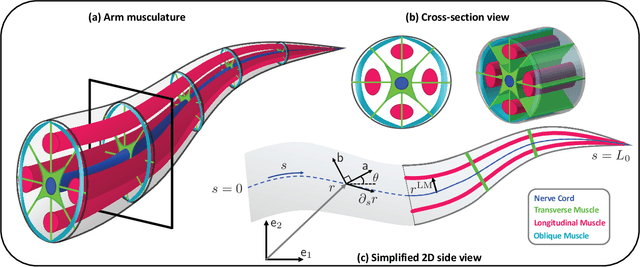
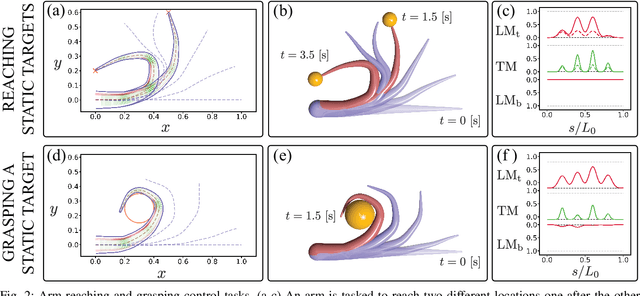

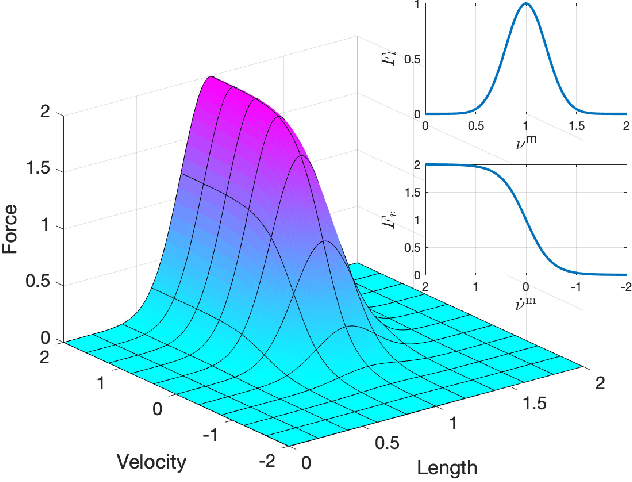
Abstract:This paper entails the application of the energy shaping methodology to control a flexible, elastic Cosserat rod model of a single octopus arm. The principal focus and novel contribution of this work is two-fold: (i) reduced order control oriented modeling of the realistic internal muscular architecture in an octopus arm; and (ii) incorporation of such models into the energy shaping methodology, extending our prior work by formally accounting for muscle constraints. Extension of the control scheme to the under-actuated muscle control case involves two steps: (i) design of a desired potential energy function whose static minimizer solves a given control task; and (ii) implementing the resulting energy shaping control input into the dynamic model. Due to the muscle actuator constraints, the desired potential energy function may not be arbitrarily chosen. Indeed, the desired energy must now satisfy a partial differential equation, known as the matching condition, which is derived for the infinite dimensional Hamiltonian control system. A particular solution to those matching conditions is described, paving the way to the application of energy shaping methodology. The overall control design methodology including muscle models is implemented and demonstrated in a dynamic simulation environment. Results of several bio-inspired numerical experiments involving the control of octopus arms are reported.
Elastica: A compliant mechanics environment for soft robotic control
Sep 17, 2020
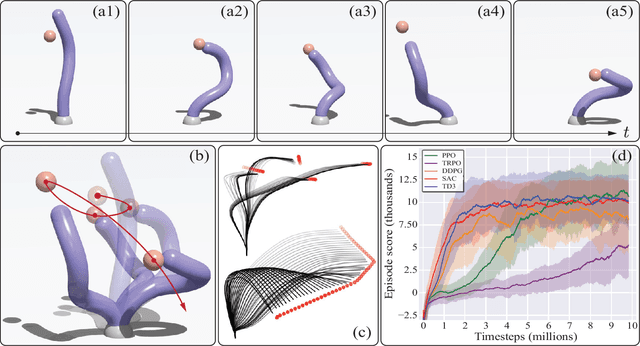
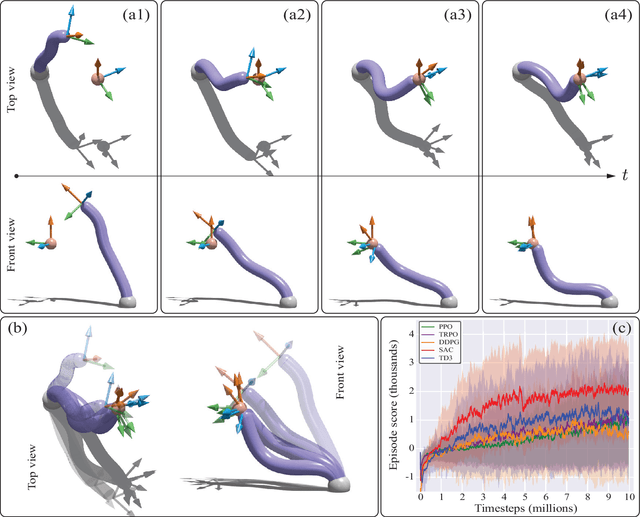
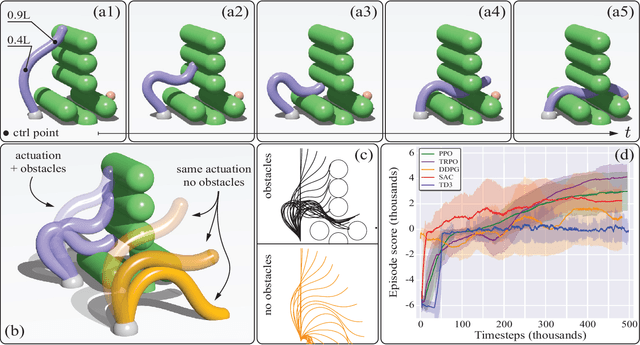
Abstract:Soft robots are notoriously hard to control. This is partly due to the scarcity of models able to capture their complex continuum mechanics, resulting in a lack of control methodologies that take full advantage of body compliance. Currently available simulation methods are either too computational demanding or overly simplistic in their physical assumptions, leading to a paucity of available simulation resources for developing such control schemes. To address this, we introduce Elastica, a free, open-source simulation environment for soft, slender rods that can bend, twist, shear and stretch. We demonstrate how Elastica can be coupled with five state-of-the-art reinforcement learning algorithms to successfully control a soft, compliant robotic arm and complete increasingly challenging tasks.
 Add to Chrome
Add to Chrome Add to Firefox
Add to Firefox Add to Edge
Add to Edge